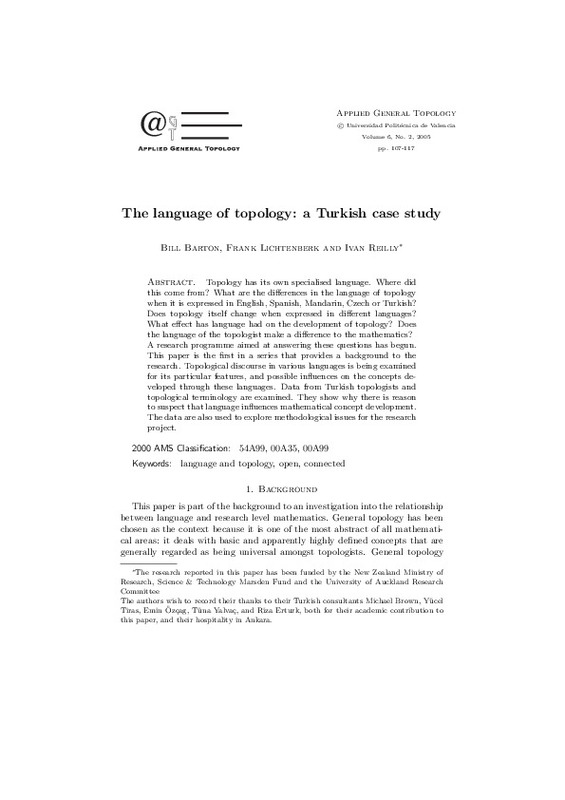B. Barton and R. Frank, Mathematical Ideas and Indigenous Languages: The extent to which culturally-specific mathematical thinking is carried through the language in which it takes place, in B. Atweh, H. Forgasz & B. Nebres (Eds) Sociocultural Research in Mathematics Education: An International Perspective, Mahwah, NJ:Lawrence Erlbaum Associates (2001), 135-149.
B. Barton and I. Reilly, Topological Concepts and Language: A Report of Research in Progress, Notices of the South African Mathematical Society 30(2) (1999), 110-119.
T. Dale and G. Cuevas, Integrating Language and Mathematics Learning, in J. Crandall (ed) ESL Through Content-Area Instruction, Englewood Cliffs, NJ: Prentice Hall Regents (1987), 9-52.
[+]
B. Barton and R. Frank, Mathematical Ideas and Indigenous Languages: The extent to which culturally-specific mathematical thinking is carried through the language in which it takes place, in B. Atweh, H. Forgasz & B. Nebres (Eds) Sociocultural Research in Mathematics Education: An International Perspective, Mahwah, NJ:Lawrence Erlbaum Associates (2001), 135-149.
B. Barton and I. Reilly, Topological Concepts and Language: A Report of Research in Progress, Notices of the South African Mathematical Society 30(2) (1999), 110-119.
T. Dale and G. Cuevas, Integrating Language and Mathematics Learning, in J. Crandall (ed) ESL Through Content-Area Instruction, Englewood Cliffs, NJ: Prentice Hall Regents (1987), 9-52.
H. Hacisalihoglu, A. Haciyev, V. Kalantarov, A. Sabuncuoglu, L. M. Brown, E. Ibikli and S. Brown, Matematik Terimleri S¨ozl¨ug¨u, Ankara: Hacettepe University (2000). G. Lewis, The Turkish Language Reform: A Catastrophic Success, Oxford: Oxford University Press (1999).
S. Mardesic, Topology in Eastern Europe 1900 – 1950, Topology Proceedings 25 (2000), 397-430.
J. Nagata, Looking Back at Modern General Topology in the Last Century, in M. Husek & J. van Mill, Recent Progress in General Topology II, Netherlands: Elsevier Science B. V. (2002), 561-564.
K. H. Parshall and A. C. Rice, Mathematics Unbound: The evolution of an international mathematical research community, 1800-1945, Providence, RI: American Mathematical Society (2001).
R. Pinxten, I. van Dooren and F. Harvey, The Anthropology of Space: Explorations into the Natural Philosophy and Semantics of the Navajo, Philadelphia: University of Philadelphia Press (1983).
M. E. Rudin, Topology in the 20th Century, in M. Husek & J. van Mill, Recent Progress in General Topology II, Netherlands: Elsevier Science B. V. (2002), 565-569.
[-]








